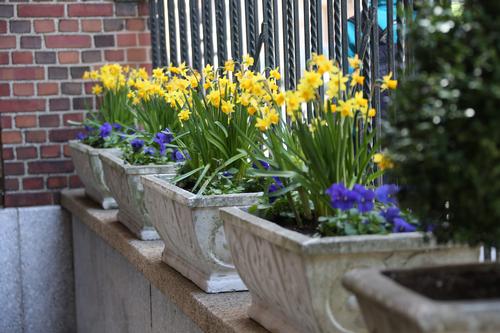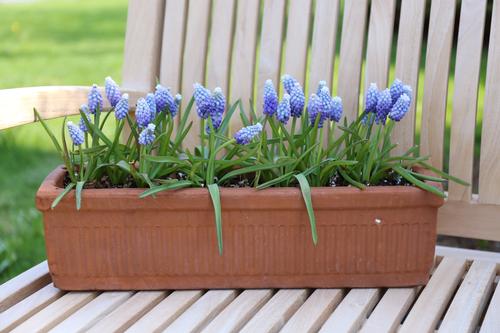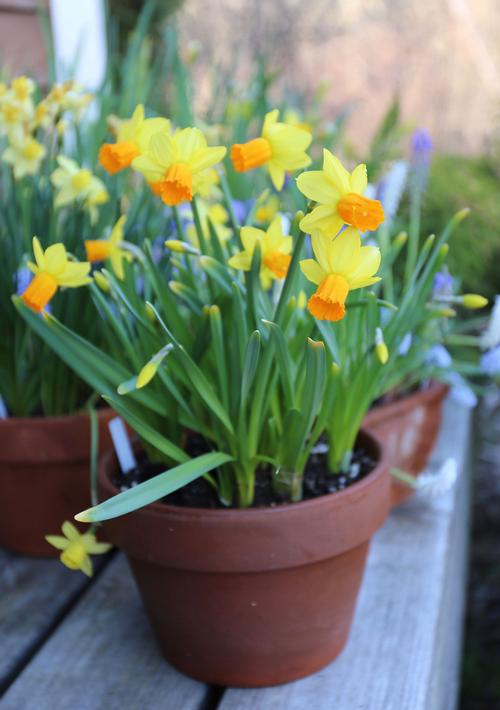Enjoy Indoor Blooms During Winter and Early Spring
Plants have internal time clocks that determine when they bloom -- daffodils in spring, roses in summer and mums in fall. But plants can be convinced to flower sooner or later than normal by using a technique called forcing. If you have ever attended a late winter flower show, you have seen thousands of expertly forced trees, shrubs, perennials and bulbs that have all been coaxed into bloom for a particular weekend.
There are two types of flowering bulbs that will bloom indoors.
No Chilling Needed: Amaryllis and Paperwhites for Winter Blooms
Amaryllis and paperwhites are winter-blooming bulbs that don't require a cooling period to trigger flowering. This is because they are native to warm climates where temperatures never drop below freezing. When these bulbs become available in late fall, they can be planted indoors immediately and will bloom 4 to 12 weeks later. Growing instructions can be found here: All About Paperwhites and All About Amaryllis.
Chilling Needed: Tulips, Daffodils, Hyacinths and other Spring-Blooming Bulbs
Spring-flowering bulbs require a chilling period before they will bloom. Cold temperatures (35-45°F) stimulate a biochemical response that "turns on" the bulb and tells the embryonic flower to start developing. If these bulbs don’t go through an extended period of cold temperatures, they either won’t bloom or their flowers will be poorly formed.

Which Types of Spring-Blooming Bulbs to Force
The best candidates for forcing are crocus, hyacinths, muscari, tulips and daffodils. For tulips, good varieties for forcing include ‘Apricot Beauty’, ‘Princess Irene’, ‘Attila’ and ‘Monsella’. For daffodils, try ‘Tete-a-Tete’, ‘Jenny’, ‘Ice Follies’ and ‘Cheerfulness’. Though you can mix different types of bulbs in the same container, it's easier to get good results if you stick with just one.

When to Plant Spring-Blooming Bulbs
Bulbs that you are planning to force can be planted in pots at the same time you are planting bulbs outdoors -- anytime during October or November. The bulbs should be fresh, firm and not dried out.
What to Plant Them In
Forced bulbs look best in shallow pots that are 4 to 6” deep. The pots should have a drainage hole in the bottom. Using a standard potting mix, put several inches of soil in the bottom of the container and then set the bulbs on top, pointy-end up. Forced bulbs look best when they’re planted very closely together with the bulbs almost touching each other. Cover the bulbs with more soil, until the tips are about an inch below the soil surface and then label each pot so you know what’s been planted. Water thoroughly to settle the bulbs in place.

Where to Store The Bulbs
Finding the right place to chill your bulbs is important. If you live where winters are moderate (zone 7) it’s relatively easy. The potted bulbs can simply be left outdoors as long as the soil doesn’t freeze or get waterlogged.
In climates where winter temperatures typically drop well below freezing (zones 3-6), the bulbs need to be stored in a protected place where the soil will not freeze. An unheated basement, attached garage, ventilated crawlspace or cold frame can work well. A spare refrigerator is ideal as long as it doesn’t contain any fruit. As they ripen, apples, peaches, pears and most other fruit emit ethylene gas, which will damage the bulbs.

How to Care for the Bulbs
During the chilling period, the soil in the pots should be barely moist. The pots must be kept in complete darkness or the bulbs will start growing before they're fully chilled. The temperature needs to maintained at 35 to 45°F throughout the entire chilling period. Recommended minimum chilling times are as follows (extra chilling time is fine):

Glory-of-the-Snow (Chionodoxa): 15 weeks
Crocus: 15 weeks
Hyacinths: 13-16 weeks
Grape Hyacinth (Muscari): 12-15 weeks
Daffodils: 16 weeks
Siberian squill (Scilla siberica): 12-15 weeks
Tulips: 14-20 weeks
Snowdrops (Galanthus): 12-15 weeks
Iris reticulata: 13-15 weeks

Time for Spring
Once the bulbs have been fully chilled, you can start bringing the pots out into a warmer location. To extend the show, bring out a few pots at a time. Place the bulbs in a cool place (50-55°F) and give them plenty of bright, indirect light. This will help keep the stems and foliage from flopping. Depending on how much the bulbs have grown while in cold storage, it may take 2 to 3 weeks for them to bloom.
After the flowers fade, the bulbs can be transplanted outdoors into a spot in the garden. Tulip bulbs that have been forced should be tossed as they will not bloom a second time.
To learn about planting spring-blooming bulbs in containers for outdoor display, read: How to Grow Spring Bulbs in Containers


